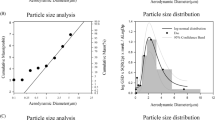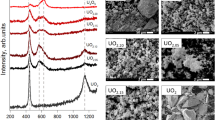Abstract
THE harmful effects of inhaled plutonium have been demonstrated in numerous experiments with animals1–4. These investigations emphasized the need for methods of removing plutonium in the event that it is deposited in the respiratory tract of human beings. This reports the results of tests with ‘Pluronics F68’ (polypropylenoglycolethylene oxide polymer) (Wyandotte Chemical Co., Wyandotte, Michigan) and DTPA (diethylenetriamine-pentaacetic acid) (provided by Geigy Research Laboratories, Yonkers, New York) in dogs to determine their effectiveness in removing plutonium following inhalation of 239PuO2. ‘Pluronics F68’ is a surface active agent and is relatively non-toxic. According to the manufacturer the LD50 dose for acute oral toxicity is 15 g/kg, and no toxic symptoms occur in dogs given 0.1 g/kg intravenously. DTPA is a chelating agent which has been shown to increase the excretion of intravenously administered plutonium in rats5. It has also been shown to increase the excretion of plutonium by human beings6. However, since the route of entry, the body burden, and the chemical form of the plutonium were not known in the case of the human exposures, the effectiveness of DTPA in removing inhaled plutonium has not been specifically evaluated.
This is a preview of subscription content, access via your institution
Access options
Subscribe to this journal
Receive 51 print issues and online access
$199.00 per year
only $3.90 per issue
Buy this article
- Purchase on Springer Link
- Instant access to full article PDF
Prices may be subject to local taxes which are calculated during checkout
Similar content being viewed by others
References
Bair, W. J., and Willard, D. H., Rad. Res., 16, 811 (1962).
Park, J. F., in Hanford Biology Res. Ann. Rep. for 1962, HW-76,000 (Hanford Laboratories, Richland, Washington) (in the press).
Temple, L. A., Marks, S., and Bair, W. J., Intern. J. Rad. Biol., 2, 143 (1960).
Lisco, H., Lab. Invest., 8, 162 (1959).
Smith, V. H., Nature, 181, 1792 (1958).
Bair, W. J., and Willard, D. H. (accepted for publication in Health Physics).
Tombropoulos, E. G., and Bair, W. J., Nature, 196, 82 (1962).
Author information
Authors and Affiliations
Rights and permissions
About this article
Cite this article
TOMBROPOULOS, E., BAIR, W. & PARK, J. Effect of Diethylenetriamine-pentaacetic Acid and Polypropylenoglycolethylene Oxide Polymer on Excretion of Inhaled 239PuO2 in Dogs. Nature 198, 703–704 (1963). https://doi.org/10.1038/198703a0
Issue Date:
DOI: https://doi.org/10.1038/198703a0
Comments
By submitting a comment you agree to abide by our Terms and Community Guidelines. If you find something abusive or that does not comply with our terms or guidelines please flag it as inappropriate.



